Dia- MCB181R Exam 4
1/207
There's no tags or description
Looks like no tags are added yet.
Name | Mastery | Learn | Test | Matching | Spaced |
|---|
No study sessions yet.
208 Terms
Gene
A sequence of DNA that encodes a protein
Trait
The physical manifestation of a gene or set of genes. Also called a phenotype
Genotype
gives rise to the Phenotype. The particular combination of alleles present in a given organism
Alleles
gene’s several different variations. Slight variation in its specific nucleotide sequence from one organism to the next.
Homozygous
An organism that can inherit 2 of the same allele for a particular gene.
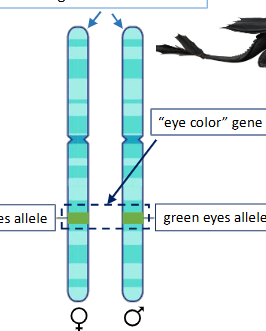
Heterozygous
Organism can inherit 2 different alleles for a gene. What the associated trait ends up looking like depends on which allele is dominant.
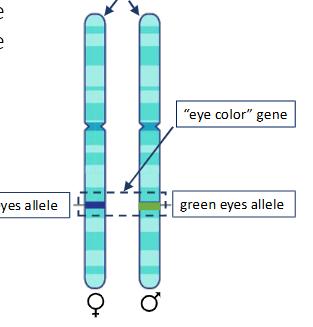
Basis of Inheritance
IN meiosis 1, which homolog ends up in each daughter cells is independent for each chromosome- based on random orientation of homologs during metaphase. We can predict the chances of offspring inheriting particular combinations of alleles using the mathematical rules of propbability.
2 key principles:
The segregation of alleles of each gene in genome. Individuals inherit 2 alleles of each gene. WHen that individual forms its own gametes, those 2 alleles separate equally into each gamete.
The two alleles of one genes on one chromosome segregate into gametes independently. The independent assortment of different genes on different chromosomes
The law of Segregation
This reflects the separation of homologogous chromosomes during anaphase 1 of meiosis.
When heterozygous F1’s form their own gametes, A allele and a allele will get separated. When meiosis 2 is comple, ½ the gametes will contain A and the other ½ a.
the two alleles of each gene separate during gamete formation (meiosis)
each gamete receives only one allele for each gene.
Independent Assortment of genes
Reflects the fact that random alignment of homologs during metaphase 1
During crossover in Prophase 1, alleles of 2 genes on a chromosome can get “recombines if crossing over occurs between where they are located (their loci) along the chromosome
The allele combinations that were originally together in each chromosome (A with B and a with b) have recombined (A with b and a with B) in 2 of the 4 chromatids.
Each daughter cell (haploid gamete) at the end of the meiosis 2 receives one chromatid which one of the following genotypes: AB, Ab, aB, or ab
Most homologous chromosomes have one or more crossover. All of which are independent events
3:1
Ratio of recessive phenotype in F2. probabilities of each phenotype in next gen. Expected ratio of dominant:recessive phenotypes
Punnett Square
The probabilities of different allelic combos from this union can be determined in this.
1 (AA): 2 (Aa) : 1 (aa)
Probability of each genotype in next generation.
Dihybrid crosses
A genetic cross that examines the inheritance of two traits at once. This is how Mend established the 2nd principle of inheritance. This is when he tracked two traits on 2 different chromosomes over successive generations.
F2 Generation
The generation resulting from a cross breed from F1 individuals.
9:3:3:1
When you cross heterozygotes for 2 genes to each other, you get this phenotypic ratio..
There are 9 possible genotypes and 4 possible phenotypes.
Results from independent assortment of 2 genes when 1 allele of each gene is dominant and when the two genes affect different traits.
Non-Recombinant
Independent assortment of A and B did not occur.
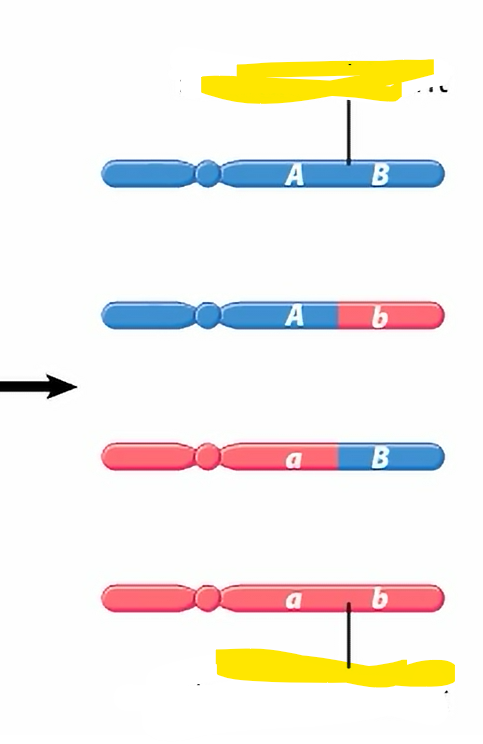
Frequency of Recombination between Genes
on a single chromosome, it depends on their physical distance from each other on the chromosome.
Scientist can use this across generation to map the relative locations of genes on a chromosome
Genes close to each other
the less likely crossing over will occur between them
rarely get recombined, and are said to be linked to one another
Law of Independent Assortment
genes on different chromosomes segregate independently of one another.
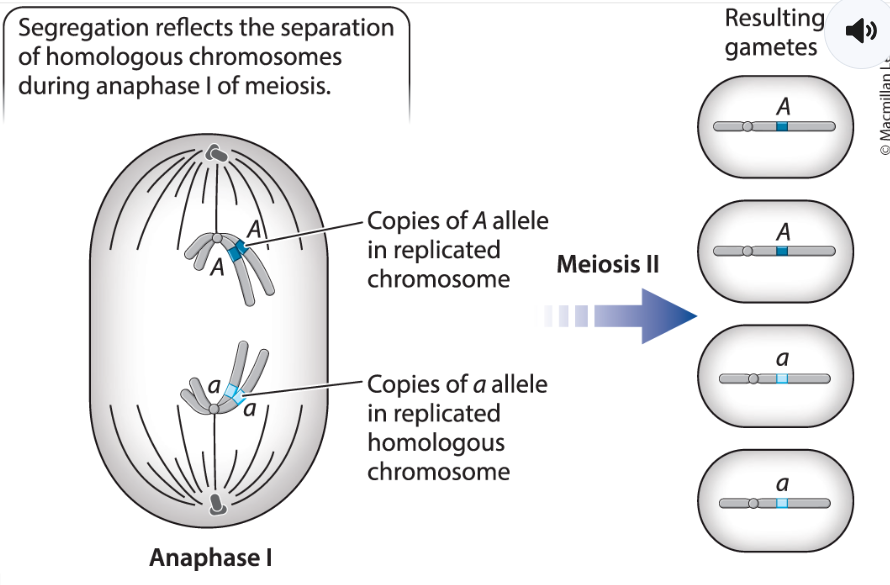
Locus
a particular position, point or location on a chromosome
NonHomologous Chromosome
chromosomes that contain different sets of genes
Hybridization
The interbreeding between two different varieties or species of an organism.
True Breeding
The physical appearance of the offspring in each successive generation is identical to the previous one
P1 Generation
The parental generation in a series of crosses
F1 Generation
The first offspring or filial, generation
Reciprocal Crosses
Crosses like these, in which the expression of the trait in the female and male parents are interchanged.
Diploid Organisms
In this, The molecular basis oof dominance in this case is the fact that only one copy of a gene is needed to carry out its proper function
1:2:1
Expected Ratio of AA:Aa:aa genotypes.
The Principle of Segregation
The alleles in heterozygous individuals become sparated in the gametes and appear in 1:1 ratio
The segregation of alleles reflects the separation of chromosomes in meiosis. Homologous chromosomes separate during anaphase 1 of meiosis 1, leading to the segregation of the alleles. Chromosomes display independent assortment during meiosis when they are sorted into daughter cells randomly.
How do the mechanics of meiosis and the movement of homologous chromosomes underlie Menndel’s principles or segregation and independent assortment?
If you know the genotypes of the parents, you can determine the alleles that occur in each gamete by applying Mendel’s principles of segregation and independent assortment. One systematic approach makes use of a Punnett Square, which predicts the probability of every possible combination of one maternal allele with one paternal allele for a particular cross. F
How can you predict the genotypes and phenotypes of offspring if you know the genotypes of the parents?
Principle of independent assortment
States that segregation of one set of alleles of a gene pair is independent of the segregation of another set of alleles of a different gene pair. It is obsesrved when genes segregate independently of one another. Also reflect the random alignment of chromosomes in meiosis.
Linked genes
Not all genes undergo independent assortment. Gene near one another in the same chromosome do not assort independently of one another. This is the genes in the same chromosomes that fail to show independent assortment. They also tend to move together into gametes
Epistasis
The gene products can interact to affect the phenotypic expression of the genotupes, resulting in a modification of the expected ratio. interaction between genes that modifies the phenotypic expression of genotypes.
Types of these leading to different modification of the 9:3:3:1 ratio. Among the more common modified ratios are 12:3:1, 9:3:4 and 13:3
recombinant
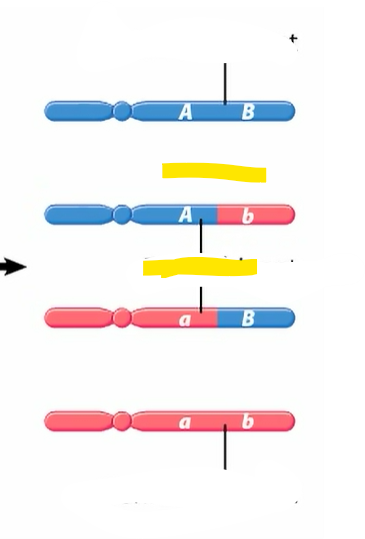
Only two of the 4 products of meiosis are recombinant because crossing over takes place at the four-strand stage of meiosis. With 2 strands that are recombinant and 2 that are nonrecombinant, the frequency of recombination is 2/4= 50% and so this is the maximum
Why is the upper limit of recombination 50% rather than 100%?
Independent assortment means that a doubly heterozygous genotype such as A B/a b produced gametes in the ratio 1/3; A B ; 1/4 ; A b : 1/3 ; aB : 1/4; ab. The first and last are nonrecombinant gametes, and the second and 3rd are recombinant gametes. The frequency of recombination is therefore 1/4+ 1/4 = ½ or 50%. This means that independent assortment is observed for genes that are far apart in the same chromosom as well as for genes in different chromosomes
For 2 genes that show independent assortment, what is the frequency of recombination?
The closer, or more tightly linked, that two genes are to each other, the smaller the frequency of recombination because it is less likely that a crossover event would take place in the interval between them. The farther two genes are from each other, the greater the frequency of recombination becusae there would be a greater chance that a crossover event will happen in the interval between the genes. The frequency of recombination can be used as a measure of distance between the genes.
How can recombination frequency be used to build a genetic map?
Inheritance Patterns for a Trait
These can be due to
Different degrees of dominance
Genes carried in the sex chromosomes are transmitted fdifferently in and in female (X- linked and Y-linked genes)
Genes that are close together on the same chromosome do not undergo independent assortment (linkage)
Mitochondria and chloroplast DNA follow their own inheritance pattern
Sex chromosomes segregate into separate gametes during meiosis like any other chromosomes.
Sex Chromosomes
Similar to autosome (non-sex chromosomes 1-22) in many ways, but also some key differences. chromosomes that determine the biological sex of an individual
Which are designation as the X-chromosomes and the Y chromosome.
Similarities of Sex Chromosomes and Autosomes
Sex chromosomes are paired, just like any other chromosomes (either two X’s or X+Y)
Sex chromosomes go through meiosis , along with all other chromosomes
Differences of Sex Chromosomes and Autosomes
The sex chromosomes for one of the two biological sexes are non-homologous. In humans, males have one X and one Y chromsoomes. Females have homologous sex chromosomes

Almost none of the genes in the X chromosomes have counterparts in the Y chromosomes.
The tips of the arms of the X and Y chromosomes share a small region of homology (red) so they can pair up during synapsis
Why do males have very little crossing over X and Y during prophase 1?
Random Fertilization
During sex results in an expected ratio of ½ XX (female) ½ XY (male) progeny
Sex Bias
reasons why genes on the sex chromosomes show non-Mendelian patterns of inheritance.
For example, the gene for red-green color vision is carried on the X-chromosomes and using a punnett square, we can figure out why males are more likely red-green colorblindness.
X-linked inheritance
traits differ from Medelian inheritance patterns because inheritancce of recessive phenotypes is sex-specific. Refers to the transmission of genes that are found on the X-chromosomes across generations
Recesive phenotyppes are expressed more often in males because males have one one X chromosomes (and thus only need one recessive allele to express phenotype)
Human Genetics
More difficult to study because
fewer offspring
keeping track of generation is difficult (long generation times_
Cant force amtings between people with genotype/phenotypes of interest
Pedigrees
Useful tools to study human genetics. Allow us to track patterns of inheritance based on phenotype (from which we can infer genotype). It is a diagram of family hisotry that summarizes the record of the ancestor/descendant relationships among individuals
Anatomy of Pedigrees
includes symbols representing individuals and relationships, with circles for females and squares for males, and lines indicating mating and offspring connections. They help visualize inheritance patterns across generations.

Affected Individuals
Mostly males because they only need one copy of mutant gene to be affected and its a typical pedigree of an X-linked recessive trait.
Can have unaffected sons because males transmited their affected X only to their daughters if the son is unaffected
The heterozygous daughters of affected males carry the mutant X and can thus have affected sons
Appear in each generation
From matings in which one parent is affected, about ½ the offspring are affected
Autosomal Dominant Trait
Can use pedigrees to track other types of traits. These are the traits associated with a gene on autosomal chromosomes that’s expressed when an individual is heterozygous or homozygous for the affected allele. They appear in every generation.
Affected individuals are equally likely to be females or males
Most matings that produce affected offspring have only one affected parent. When a trait is rare, mating between two affected individuals are extremely unlikely. if so, then affected individuals will laways be heterozygous (Aa)
Among Mating in which 1 parent is affected, approximately half the offspring are affected
In a mating in which 1 parent is hetero dominant (Aa) and the other is homo(aa), half the offspring are expected to be hetero (Aa) and the other half will be homo recessive (aa)
One copy of a mutant allele is enough to express the trait
Autosomal Recessive Trait
can use pedigrees to tract this traits that are associate with a gene on autosomal chromosome that is expressed only when individual is homozygous for the affected allele.
The typical pedigree of an autosoal recessive trait.
Males and females are equally likely to becom affected.
Typically skips one or more generations.
Unaffected parents can have affected kids because carriers dont manifest the affected phenotype.
Affected individual may have unaffected parents
For this trait that is rare, almost all affected individuals have unaffected parents .
Affected individuals often result from mating between relatives, typically first cousins (because of the familial prevalence of carriers)
Has these characterisit because these alleles can be transmitted from generation to generation without manifesting the phenotype.
If both parents are unaffected carriers of the allele, they both have the genotype Aa, and ¼ of their oddspring are expected to be homozyggous aa and affected
Autosomal Gene
Refers to a gene that is not found on a sex chromosome. These genes follow standard Mendelian inheritance patterns, they are inherited in pairs and can be dominant or recessive.
Requirement of the Cell
A membrane separating the inside of the cell from the outside
A way to encode and transmit infromation on how to build and maintain a cell
Energy
Cellular Life
A biochemical reaction
Biochemical Reactions
Require Energy.
Cell signaling, Transcription, mRNA splicing, translation, epigenetic, DNA replication, mitosis, meiosis are all drive that follow cellular processes.
The law of Thermodynamics
Determine whether a chemical reaction requires or release free enegy
Gibbs Free Energy (G)
Free energy (availabile to do work)
Net Change
Whether a chemical’s reaction will require energy or release it depends on this in Gibbs Free energy between the reactants and the products (deltaG)
also The total gain or loss after adding and subtracting everything.
Endergonic
Nonspontaneous, Reactions with a positive deltaG requires an input of energy
Ex: Chemical energy increases (positive deltaH) and the degree of disorder decreases (Negative deltaS).
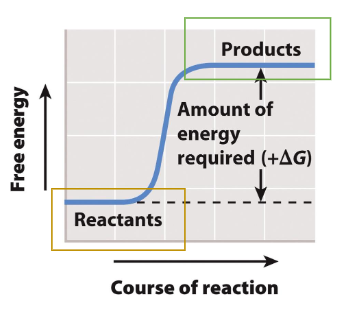
Exergonic
They will occur spontaneousy and these reactions have a negative deltaG release energy.
Even thhese spontaneous reactions don’t always proceed quickly on their own because of activation energy.
Example: The hydrolysis of ATP
Not all cells are spontaneous. Anabolic reactions are a good example.
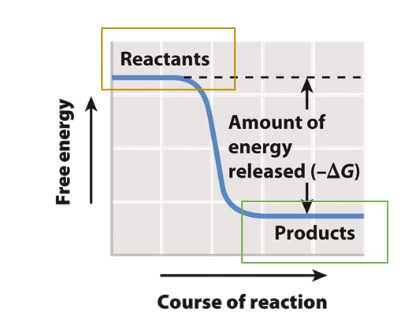
Transition State
In order to get from reactant to product, the reacting atoms must go through this that has a higher free energy than the reactants. It is highly unstable and therefore has a large amount of free energy.
This reaction is spontatnous because free energy of the reactant is higher than the free energy of the product and delta G is negative.
Corresponds to the highest free energy
Activation Energy
Difference in free energy between reactants and transition states
Enzymes
This is how cells overcome this energy barrier. The “ase proteins” reduce activation energy so rx can proceed. Can reduce the activation energy, but they do not change the total deltaG of the reaction.
Will couple exergonic ATP hydrolisis w/ endergonic reactions so energy release from one can directly “fuel” the nergy required by other
Increase reaction rate and decrease activation energy. Do not change other parametes
Acts as substrates that bind to its active site.
Can increase the rate of chemical reactions dramatically
Redce EA of a chemical reactions
Lowering Activation Energy
Enzymes make reactions go faster
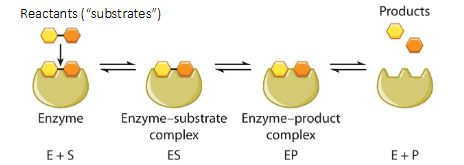
Because enzymes can stabilize the transition state
how does lowering activation energy make enzymes make reactions go faster?
An example of exergonic
The digestion of proteins from food into amino acids
Cell Metabolism
The sum of all chemical exs that occurs in a cell is referred to as this. It is driven by the building up and breaking down of carbon sources to harness or release energy.
Sometimes the cell needs to build molecules
Anabolism
Cells in which synthesis of RNA strand in transcription build molecules, require free energy +deltaG, and in the form of ATP usually
Ex: the synthesis of macromolecules such as carbohydrate and proteins
Decrease entropy because they use individual building blocks to synthesize more ordered molecules such as protein or nucleic acids
Catabolism
The cells needing to break down molecules into smaller unit. Like to extract energy stored in its bonds. It releases free energy, negative deltaG in the process, produce ATP
Results in an increase of entropy as a single ordered molecules is broken down into several smalles ones with more freedom to move around
ATP
always involved in both anabolism and ccatabolism . This can store the perfect little dose of energy driving chemical reactions. Through energetic coupling, this powers nearly all cell functions.
A form of chemical energy
A readily accesible form of cellular energy
The chemical energy in the bonds of this is used to drive many cellular processes such as muscle contraction, cell movement, and membrane pumps
this is a molecule of adenosine covalently linked to 3 phosphte groups with high potential energy
Made up of the base adenine and 5 carbon sugar ribose and is one of the 4 building blocks of DNA and RNA. To complete the molecule, ribose is attached to triphosphate or 3 phosphate groups
ATP; ADP
When ___(3P’s) is hydrolyzed into ___ (2Ps) it releases moderate amount (7.3 kcal/mol) of free energy (i.e, an exergonic reaction)
This releases energy and can be used to do work.
Making ATP
A main priority for a ll cells. which bring us to cellular respiration
Cellular Respiration
A series of chemical reactions collectively. ATP package this energy into a chemical form that is readily accessible to the cell.
The goal of this is to break down the food eat and make ATP out of it..
The process of this extracts and package that energy in a readily available format (i.e, ATP) for fueling rxs.
Also a series of catabolic reactions
Cellular Respiration Stage 1
Glycosis: Fuel molecules are partially broken down producing ATP ANd electron carriers.
The reaction are taking place in Cytoplasm
The inputs are: Glucose, 2 ATP, 2NAD+
Outputs are 4ATP, 2 NADH, 2 pyruvate
ATP’s payoff is 2 net ATP
Potential energy stored in chemical bonds, ATP, electron carriers (NADH), electromechical graduent
Fermentation: allows glycosis to continue in the absence of oxygen
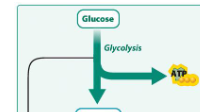
Cellular Respiration Stage 2
Pyruvate oxidation and citric acid cycle, where glucose derivatives are further broken down to generate more ATP and electron carriers.

Cellular Respiration Stage 3
Citric Acid Cycle: Fuel molecules are fully broken down, prdocuing ATP and electron carriers. Generated the most NADH which will be used oin oxidative phosphorylation to produce ATP. This is where original Glucose gets fully oxidized
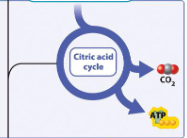
Cellular Respiration Stage 4
Electron carriers then go to the electron transport chain, and oxidative phosphorylation occurs. Electron carriers donate electrons transport chain, leading to the synthesis of ATP.
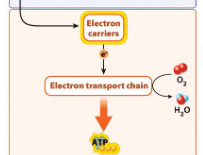
because ATP Stores just the right ammount of energy to drive endergonic reactions—enough to power them without being wasteful—and this energy is readily accessible through its high energy phosphate bonds
Why is making ATP Important for cells?
Substrate-Level Phosphorylation of ADP and Oxidative Phosphorylation of ADP
ATP is produce in these ways in cellular respiration
Substrate-level phosphorylation
A phosphate is transferred from one molecule to another (occurs in first few steps of cellular respiration).
an example of this is during the cell cycle, the cyclin/CDK complex phosphorylates target proteins that promote the cell cycle.
Oxidative Phosphorylation
Electron movement is coupled to ATP synthesis.
this occurs through a series of couples oxidation and reduction or redox reactions that transfer electrons from one molecule to another
A way more efficient process than 1:1 substrate-level phosphorylation
Overall Process of coupling Electron Transport Chain and Chemiosmosis to make ATP
The only time this occurs is when electron carriers will carry electrons to the final step of cellular respiration.
Inputs: 10 NADH, 2FADH1
Outputs: 32-36 ATP
ATP’s “payoff” 32-36 ATP
The potential energy is stored throughout the electron carriers (NADH , and FADH2)
Redox Reaction
Involves transferring electrons from one molecule to another.
Example: we are transferring electrons from molecule A to molecule B. When A has donated (gotten rid of) its electrons, we say it is oxidized. When B accepts (gains) those electrons from A, it becomes “reduced”
Happens at all stages of cell respiration
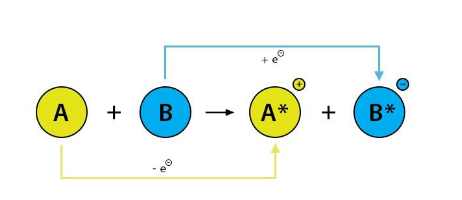
Electrons
Can contain a lot of potential energy. Come from the covalent bonds in glucose
During a redox rx
When an electron is transferred from a donor molecule to an acceptor molecule, some of that energy is released. That is why transferring electrons from one molecule to another such a great way to make ATP
Released Energy
Can be harnessed to perform work (in oxidative phosphorylation, it’s harnessed to power a super machine that pumps out of 2-4 ATP for every pair of e-!)
First Stages of Cellular Respiration
Dedicated to extracting electrons from covalent bonds in glucose (and its subsequent derviative) via oxidation, then transferring them to electron carriers via reduction
NADH and FADH2
Electron Carriers. These are also the reduced forms because you add 2e- and H+

NAD+ and FAD
The oxidized form of electron carriers.

Reduced Molecule
How to determine if this happens is to follow the H+ (or gained Electron)
The X and Y chromosomes can pair during meiosis through regions of homology located near the tips of the chromosomal arms
How can the human X and Y chromosomes pair during meiosis even though they are of different lengths and most of their genes are different?
Meiosis in females results in X-bearing eggs only. In contrast, meiosisin males results in a 1:1 ratio of X-bearing and Y-bearing sperm. Random fertilization of the egg results in a 1:1 ratio of female: male offspring.
What is the biological basis for the 1:1 ratio of males and females at conception in mammals?
Homology
(the red part). The tips of the arms of the X and Y chromosomes share a small region of this. Very few of the genes in the X chromosome have counterparts in the Y chromosome.

1:1
The expected ratio of females:males refers to the sex ratio at the time of conception. This is also a patteriah that MOrgan observed in the F2 generation of his crosses
Secondary Sex Ratio
This sex ratio at birth can be observed, which differs among population but usually shows a slight excess of males.
the phenotype outcomes of females compared to males could be different
A cross involving an autosomal gene versus a sex linked gene would in that:
X-Linked Genes
Sometimes called Sex-linked genes. These are genes in the X-chromosomes.
ALso provided the first experimental evidence that genes are in chromosomes
Wild Type
The most common allele, genotype, or phenotype present in a population; nonmutant
Genes in the X-Chromosomes
Exhibit a crisscross inheritance pattern
2 Important Principles governing the inheritance of X-Linked Genes
The phenotypes of the XX offspring indicate that a male transmit his X chromosomes only to his female offspring. In this case, the X chromosomes transmitted by the male carries the white-eye mutation
The phenotypes of the XY offspring indicate that a male inherits his X-Chromosomes from his mother. IN this case, the X chromsome transmitted by the mother carries the nonmutant allele of the gene
Also called a crisscross inheritance